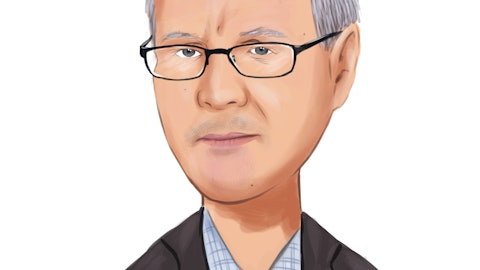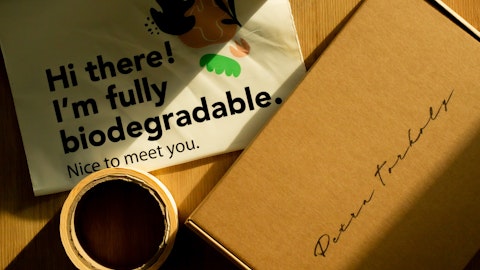Ted Doheny: Yes. Ghansham, on the second part of the question is we’re moving the portfolio as you look at 2027. So you see the shift, and we’re very consciously talking about Cryovac and that their food business and moving at the portfolio, moving it from where it was 45%, 55% to now over 60%. The fluids portfolio, if you look at it being over 10%, it’s actually another percent because part of the fluids is into our medical space. So you can see it’s becoming a very strong part of our portfolio going forward in shifting that strong growth to the food side of the business and our portfolio. But the other side of our portfolio to highlight, it’s in the Reinvent SEE, as we drive to digital and the automation is really looking at our portfolio to be a full automation portfolio.
So what does that mean? Where we’re leading with equipment where we can automate our customers’ facility and have that pull-through materials. One of our fastest-growing product lines has been in the fiber-based solutions, both food and the protective in bringing automation into that space. And as Emile was talking about with Liquibox, right now, they do very well, and we do very well with bags. And now we have fittings but the box part is a significant opportunity, as we bring some of our auto boxing, digital, technology and to pull that material through. So the portfolio is shifting in two ways, shifting to be a stronger portion of our portfolio to that very stable, high profitable business, as we’re adding fluids. But also as we continue to shift the portfolio to a full solutions model with that automation and pull-through on materials so we think, exciting for where the portfolio shift.
One other piece just to highlight it €“ I highlighted in the €“ my prepared remarks is looking at the liquids and fluids portfolio is now going to be leveraging at a 40% where the operating engine despite all of our issues, the engine has been performing and operating at a really strong leverage over and now putting a part of our portfolio that’s actually going to be more profitable than the existing base. So that 40% leverage is really going to be driving earnings over the next 5 years. Okay, next question?
Operator: Thank you. Our next question will come from the line of Phil Ng from Jefferies. Your line is open.
Phil Ng: Hey, guys. Good morning. In your full year guidance, I believe you’re baking in some share gains by a few points versus the market. Just want to get a little hand on what’s driving that? Have you kind of recapture some of the share that you may have lost last year on the food side? And it’s good to see equipment sales bounced back pretty nicely in the fourth quarter. Are most of the supply chain issues on the equipment side behind you, and that’s the opportunity as well as the access to materials, I think, on the specialty chemical side?
Ted Doheny: Yes. So just to €“ the €“ we were getting ahead on those supply chain issues on the equipment side. So I think we’re in a good shape. I think we can grow that business, and you’ll see that strong growth coming back and expecting more. The first part of the question, remind me Chris?
Christopher Stephens: So on the €“ just thinking through the food, remember, we talked about the…
Ted Doheny: Okay. The share gain on food, yes, definitely, we see that in our guidance. The part of the food we have it at 2% for the full year growth on food. And part of that is the share gain. But on the second half, we see some of that market coming back. We now have that specialty resin that we highlighted before. We definitely €“ we’re in a really good position with our food business. I mean our Cryovac materials and automation is the preference in the marketplace and as we’re driving that. Now having the material, we think we can get that share back, and that’s in part of our guidance. But it’s against a tough first half outlook. So short answer is yes, we expect that share gain back, both on materials and we expect more share gain on the automation.
Phil Ng: Have you won that share any at this point?
Ted Doheny: Well, partly, we identified that in the first to fourth quarter with the equipment coming in, that’s identifying that, that’s coming. So part of that strong fourth quarter gain on the equipment €“ the answer is yes. More to come now. More to come.
Christopher Stephens: Right. And then specific on the food side, given the specialty resins challenges, getting that back online, getting that in place, the business that went elsewhere for us in terms of dual sourcing or loss of share, we have been making slow gains in the fourth quarter and expect that to continue every quarter as we execute in 2023.
Ted Doheny: On the protective side, just if you’re asking you €“ was focused on the food, but we also think same thing as we get through the destocking and again, just really highlighting is we move specialty on the protective side where we have a distribution. Moving those distributors to online partners as we go further digital with MySEE, we definitely think it’s going to expand our reach and our capability when we get through some of this destocking on the protective side. So, we think we have some share opportunities there as well.
Brian Sullivan: Okay. Next question.
Operator: One moment for our next question. Our next question comes from the line of Anthony Pettinari from Citi. Your line is open.
Anthony Pettinari: Good morning.
Ted Doheny: Hi.
Anthony Pettinari: Hey. Following up on, I think Ghansham’s question, and I appreciate all the detail on first half versus second half. But I was just wondering if you could provide any color or put a finer point on how 1Q EPS might compare to 4Q. You talked about the protective volume weakness and I guess the cost saves are more second half weighted, and I think you have two months of Liquibox. So, just wondering how 1Q EPS might compared to 4Q? And then just some packagers have talked about steep slowdown in December, but then kind of pretty strong start in January. I am just wondering if you saw a similar dynamic across either of your businesses.
Christopher Stephens: Sure, Anthony. As you know, we don’t actually give quarterly guidance, but we would like to give €“ you guys as well as investors just to feel for the first half and second half. But we definitely, from a sequential point of view, expect earnings per share in Q1 to be down going into the year. So, you kind of €“ from a modeling point of view, think of it as 46%, 47% first half. And then as you may split it, we would expect Q1 to be a softer quarter, given what is going on mostly on the protective side. Coming off some pretty strong growth on automation in Q1, I don’t necessarily expect to see that same level of growth in Q4 of it in terms of Q1. So, anyway, some headwinds faced us in Q1 that is reflected in our view of that first half and second half.
Brian Sullivan: Operator, next question.



